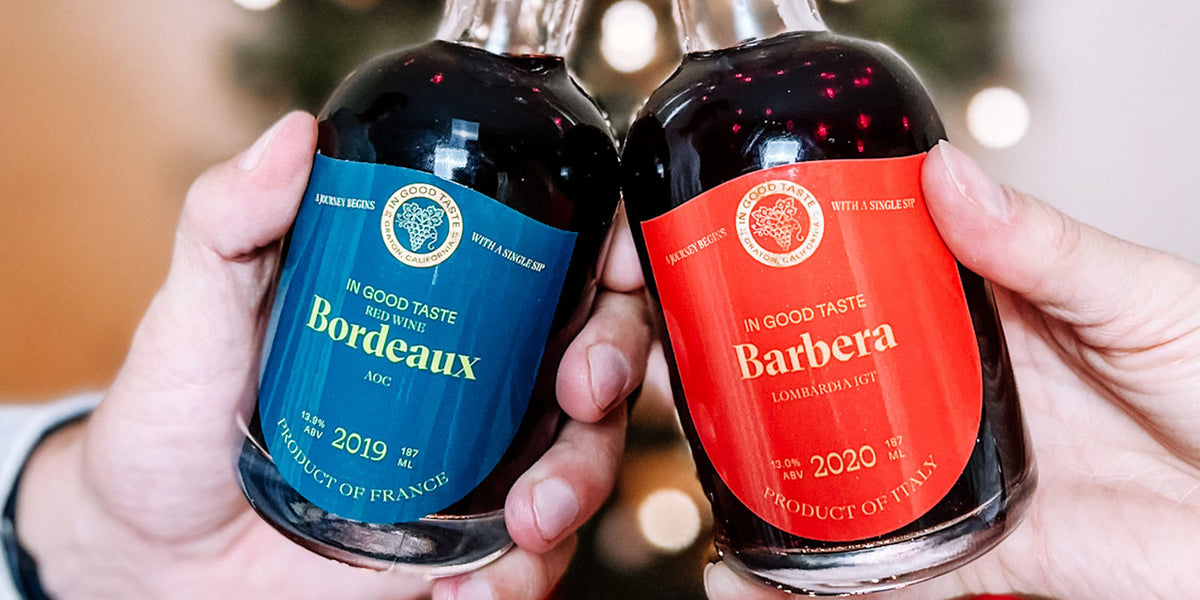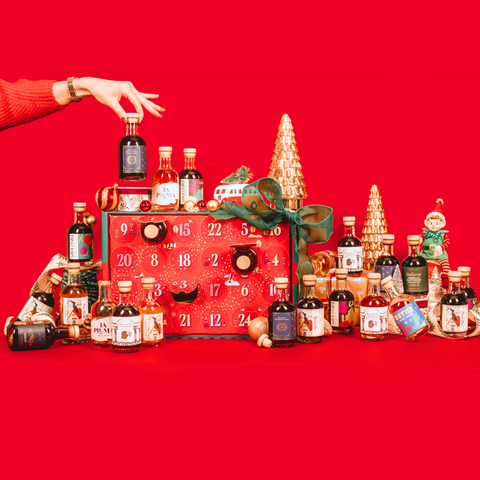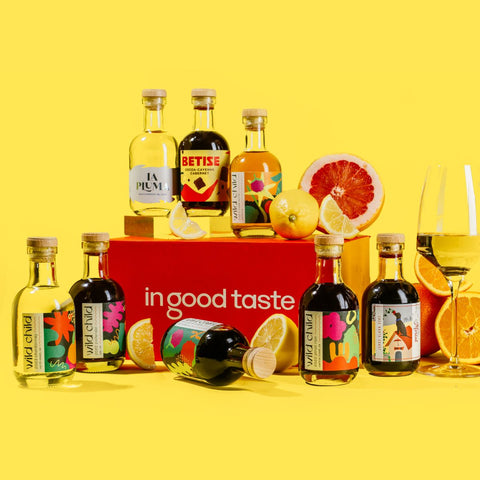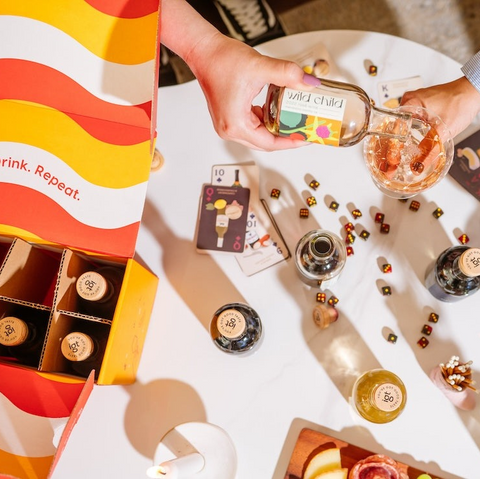Sugar who? Not around here.
A beginner’s foray into wine drinking can often times feel overwhelming. With so many terms like sweet, dry, tannins, body, and so on, it’s easy to get lost. Let’s face it; you might just want to know what tastes good!
Well, like beauty is in the eye of the beholder, “good wine” varies from person to person. While sipping a myriad of different wine varieties is the best way to learn what you like, we want to teach you the basics before you dive in. In this beginner’s guide to dry wines, we’ll touch on the difference between sweet and dry wines, dry wines for drinking or cooking, and if dry wines are good for dieting. Grab a glass, and let’s begin!
What makes a wine dry?
“Dry” refers to the perceived taste the wine leaves in your mouth because it contains low levels of residual sugar after fermentation. In contrast, sweet wine will have higher residual sugar.

When the winemaker allows the yeast to consume all the wine’s residual sugar during the fermentation process, the resulting absence of sugary sweetness leaves a delicious dry wine.
Many people think that dry wine will dry out your mouth, but this comes from misunderstanding the term. Because alcohol dehydrates, any wine could technically lead to a feeling of dry mouth. We’ll get more into the subject of “dry mouth” feel in the next section.
If you think a dry wine won’t taste fruity because it’s not sweet, you may be surprised. This is a common misconception, but all it takes is one taste of dry, fruity Chardonnay for that myth to be laid to rest.
Just because a wine is “fruit forward” does not mean it is sweet. People often mistake fruitiness for sweetness, but the vast majority of wines in the world are in fact dry! Many different wines across the board will have naturally occurring fruit notes to them, and no, that does not mean there are literal apples or strawberries in your wine.
Dry Mouth Feel from Tannins, Alcohol Levels
Let’s look a little further into dry wine misconceptions. When some people experience the dry mouthfeel — or the “pucker factor,” as some call it — after drinking red wine, they consider that a dry wine. This sensation comes from the high tannin level. Tannins are naturally occurring bitter and astringent compounds that come from the grape’s skin. Some wines like Syrah and Cab have more tannic skins.
There’s also a misconception that dry wine is always higher in alcohol. If someone likes wine with a higher ABV (Alcohol by Volume), they might think they’re drinking dry wine. Wrong again. Our brains fool us with this phenomenon because, in wines with higher alcohol content, we taste more flavors from the alcohol and less from the fruit. At this point, our taste buds relay the message, “Hey brain, there’s less moisture here,” which would rationally make us think that the wine is dry, but no. There are dessert wines with a very high alcohol content that are plentifully sweet. Another wine myth busted!
Do Dry Wines Have More Alcohol Than Sweet Wines?
Let’s circle back to the relationship between alcohol content and residual sugar. We know that dry wine has less residual sugar, and we debunked the myth that it always has high alcohol content. It’s important to remember that this doesn’t mean it never has high alcohol content — just that ABV isn’t the only metric.

The best metric for ranking wine from bone dry to very sweet lies in the residual sugars. Here’s a quick guide:
- Bone Dry: Extremely dry, contains less than 0.5% residual sugar. This level is so low that most people’s taste buds can hardly detect it.
- Dry: The general level of dryness denotes a satisfying lack of sugar or sweetness.
- Off-Dry: The tiniest bit of sweetness in a dry wine bumps it to the off-dry category. It’s still free from a sugary flavor but sweet enough to be just one step removed from a dry classification.
- Semi-Sweet: Still a bit dry, semi-sweet wines contain more than 3% residual sugar. They’re not as strong as sweet, but pretty close at this level.
- Sweet: We’re officially out of the “dry wine” woods at this level. Sweet wine has over 30 grams of residual sugar per liter.
- Very Sweet: Sugary sweet and highly concentrated, very sweet wine is sometimes called dessert wine.
Best Red and White Dry Wines for Drinking
We’ve got good news for beginners: There are more than enough red and white wine varieties in the dry category for you to find at least one you like. While most people go for white wine in warmer months and red wine when it’s chilly, the choice is ultimately up to you. To help you choose, we’ve rounded up some of the most popular dry wines in both categories.
Dry Red Wines

Cabernet Sauvignon
There’s a good chance you’ll find Cabernet Sauvignon near the top of almost every wine list. It’s a delicious, full-bodied red wine that beginners and wine connoisseurs love, and it’s one of the world’s most widely planted grape varieties. Its intense flavor can be overpowering for some, but its dry, fruit-packed flavors make it stand out from the crowd. Tasting notes can include berries, plums, chocolate, and vanilla.

Merlot
Merlot’s smooth, velvety taste brings a soft comparison to Cabernet Sauvignon. With fruity flavors and low tannin levels, it’s not quite as intense as other red wines, but it still holds its ground for flavor. Winemakers love that Merlot can taste great even with minimal aging. Wine drinkers love its chocolate and cherry flavors that pair well with a range of foods. Merlot is often used in blending to even out the tannins of higher tannic wines like Cabernet Sauvignon.

Malbec
Malbec has grown in popularity thanks to its luscious, full-bodied flavor profile. The Malbec grape develops its signature chocolate and sour cherry flavors from spending long, sweltering days in the sun before being pressed and bottled. With more subtle tasting notes like tobacco, vanilla, sour cherry, and smoke, you’ll want to sip every last drop!

Pinot Noir
Pinot Noir, known for its sophistication and complexity, is also considered the healthiest of dry red wines. Light-bodied with tasting notes of raspberry, mushroom, cherry, and blackberry, it has a pleasant balance of warm earthy and fruity flavors. If you’re looking for a versatile wine that goes with almost anything, Pinot Noir won’t let you down.
Related: How to Build the Ultimate Charcuterie Board
Dry White Wines

Sauvignon Blanc
Sauvignon Blanc’s elegant taste and high acidity will make your mouth pucker on the first sip. Although very different from the robust Cabernet Sauvignon, Sauvignon Blanc is considered one of the best wines for first-time wine drinkers. Offering a variety of flavors like pear, white peach, grapefruit, and herbal notes like lemongrass and bell pepper, it’s airy and light without being bland.

Pinot Grigio
Pinot Grigio combines mandarin orange, fuji apple, honeycomb, and lime notes with high acidity for a lovely dry white wine. Right after Moscato, it’s the second most popular white wine in the United States. Ranging from medium-bodied to full-bodied, it’s an excellent pairing for light meats like grilled chicken, roasted turkey, or seafood.

Chardonnay
Chardonnay’s versatility makes it a favorite among dry white wine enthusiasts. It can stand on its own or mix well with other wines to create complex blends. Its taste can even change based on how it’s stored or aged. Some Chardonnay is buttery, oaky and toasty from aging in oak barrels, whereas others can be zippy and tart when aged in stainless steel. Either way, it’s an easy start for beginners looking for a dry wine to drink or cook with!
Related: How to Host a Wine Tasting
Best Red and White Dry Wines for Cooking
Dry white wines may be the more popular choice for cooking wine, but reds like Cabernet Sauvignon can also enhance the right dish quite nicely. Pro Tip: cook with wine you would enjoy drinking; these flavors will concentrate as the alcohol cooks off.
Cabernet Sauvignon
Want to take red meat to the next level? Add more red – red wine that is. Cabernet Sauvignon, to be specific. Why? Because cabernet is dry, which means it won’t burn easily. This quality makes it great for making sauces. A small pour into savory stews and sauces can add depth once the alcohol cooks off and the flavors set in.
Pinot Grigio
Cooking fish tonight? Pinot Grigio elevates seafood recipes of all kinds, even enhancing pasta and sauces. The next time you’re making pesto chicken or seafood pasta, bring a bottle of Pinot Grigio. Its crisp, neutral flavor makes it a versatile accompaniment to a variety of Italian dishes.
Chardonnay
For heavy, rich dishes, pop open some Chardonnay and give your meal a dramatic flair. Its signature buttery notes bring out the best in creamy sauces for entrees like chicken and mushrooms. Chardonnay is also great with salmon, crab, and lobster. Be careful that your Chardonnay isn’t too oaky, as it might throw off the bitterness a little too much. Lightly oaked Chardonnay is a great choice, as it balances the acidity just right for most recipes.
Are Dry Wines (Less Sugar) Better for Dieting?
Now that we’re drinking and cooking with dry wine, you might wonder whether there can be too much of a good thing. Since dry wines have less residual sugar than sweet wine, you’d think this means it’s way healthier, right? Sorry, it’s not quite that simple.
The average glass of wine contains about 150 calories. Drink two, and you’re consuming roughly the equivalent of two scoops of ice cream. Of course, that’s comparing apples to oranges. But it’s the same when choosing a healthier wine. If you’re only looking to reduce your sugar intake, dry wine is a good choice. If you’re more focused on overall calories, check the nutrition facts.
Counting Calories?


A dry wine with high alcohol content can contain more calories than a sweet wine with a lower alcohol percentage. Whatever wine you choose to drink, we hope you find one that fits into whatever wellness means to you.
Can You Tell if a Wine is Dry from the Label?
Even though we’ve covered the range of sweet to dry categories from bone dry to very sweet, wine labels aren’t so clear. If you see “sec” or “troken” on a wine label, that signifies a dry wine. Terms like “dolce” and “doux” indicate sweetness, so you’ll want to stay away from those when choosing a dry wine. The best way to know whether a wine is dry or not is by familiarizing yourself with several varietals or checking a wine sweetness scale. With a range of options, you can pick your favorites from a spectrum rather than simply thinking “dry or not dry.”








